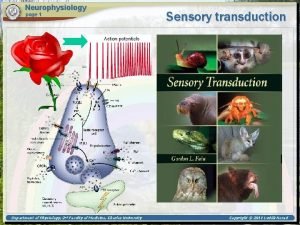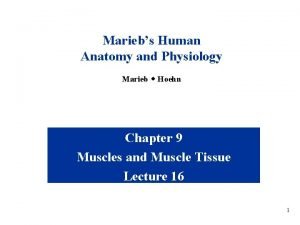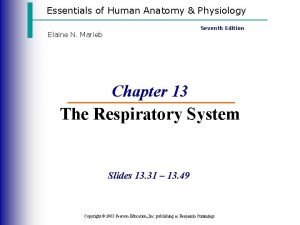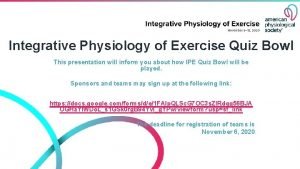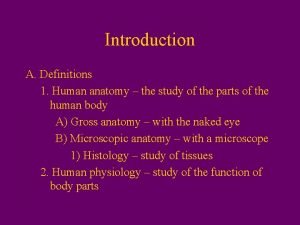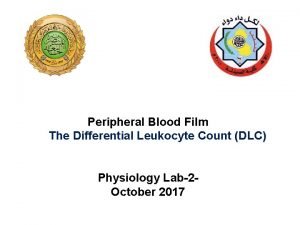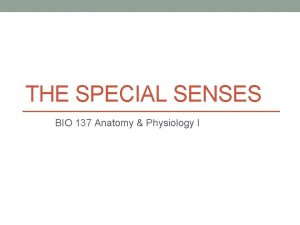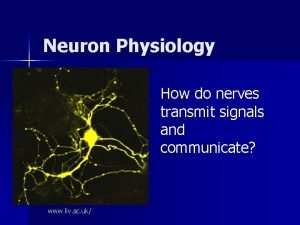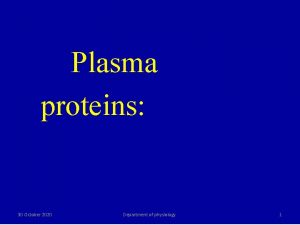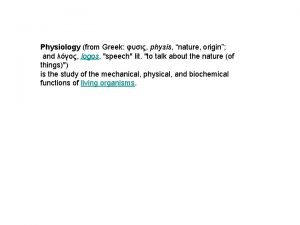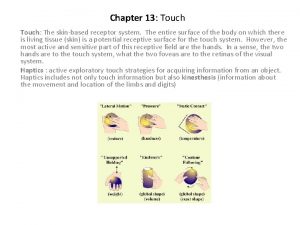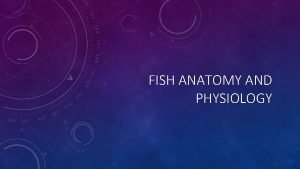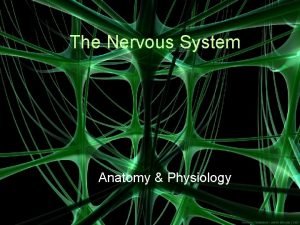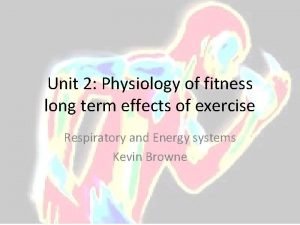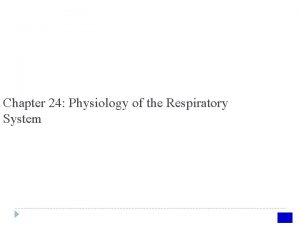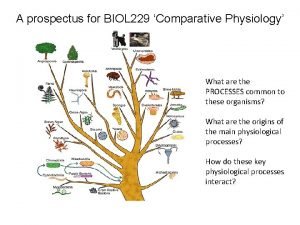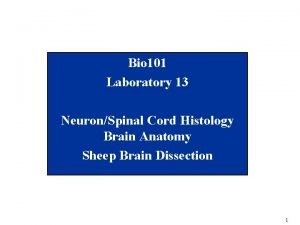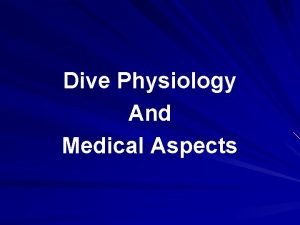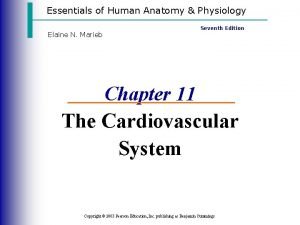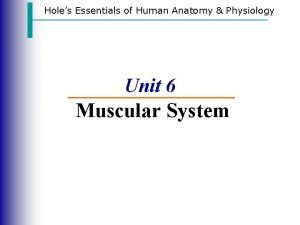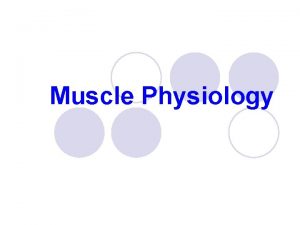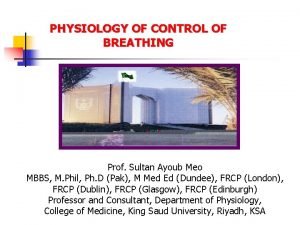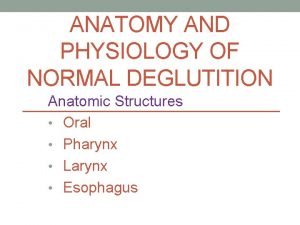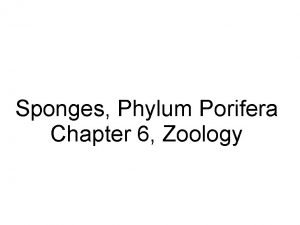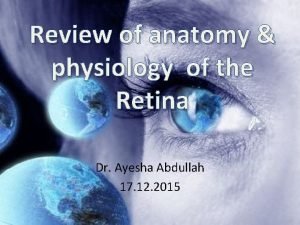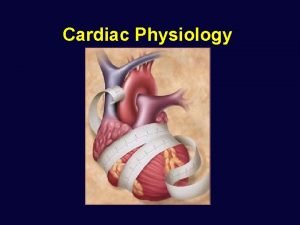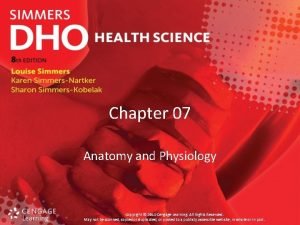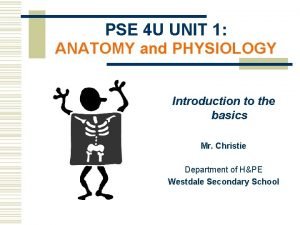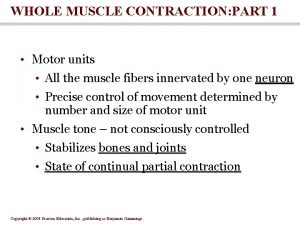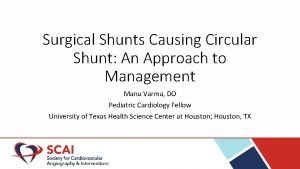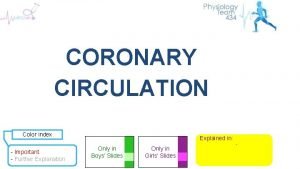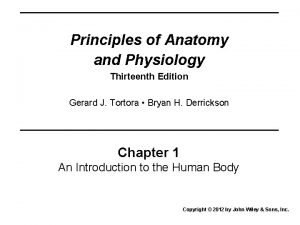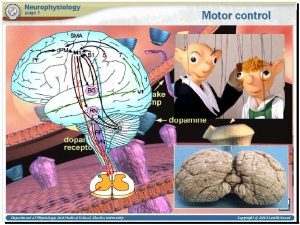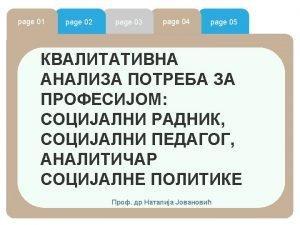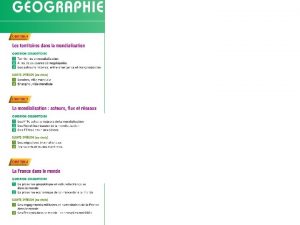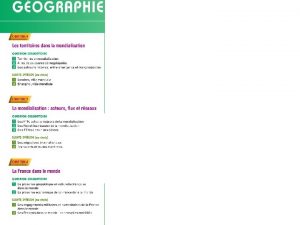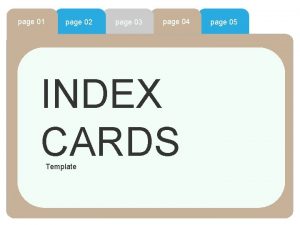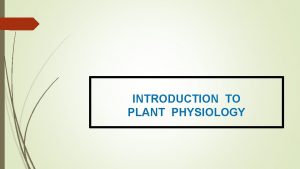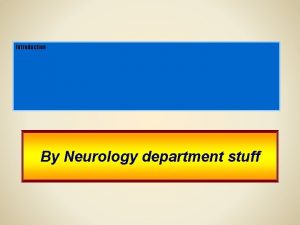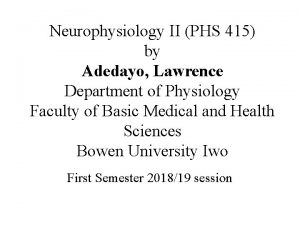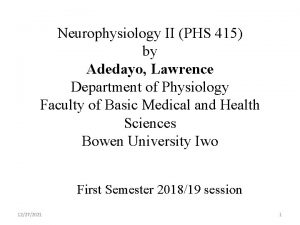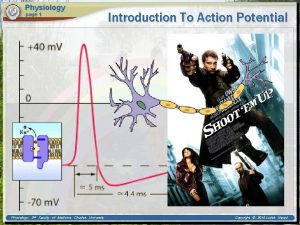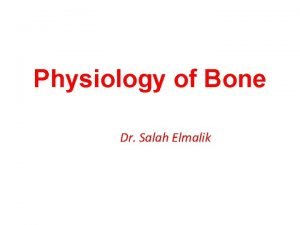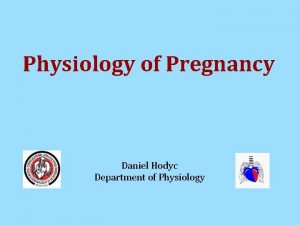Neurophysiology page 1 Department of Physiology 2 nd




















































- Slides: 52

Neurophysiology page 1 Department of Physiology, 2 nd Faculty of Medicine, Charles University Sensory transduction Copyright © 2011 Luděk Nerad

Neurophysiology page 1 Sensory transduction Reception, perception, and transmission of information The brain creates subj. experience Department of Physiology, 2 nd Faculty of Medicine, Charles University Our actions are based on what we perceive, i. e. the brain can ”read” it. Copyright © 2011 Luděk Nerad

Neurophysiology Sensory transduction page 1 How neurones communicate Action potential Department of Physiology, 2 nd Faculty of Medicine, Charles University Copyright © 2011 Luděk Nerad

Neurophysiology page 1 Sensory transduction Action potential Na+ K+ K+ Voltage-gated Na+ and K+ ion channels Department of Physiology, 2 nd Faculty of Medicine, Charles University Copyright © 2011 Luděk Nerad

Neurophysiology page 1 Sensory transduction Postsynaptic potentials Source of excitation is another neurone Neurotransmission at a chemical synapse Department of Physiology, 2 nd Faculty of Medicine, Charles University Copyright © 2011 Luděk Nerad

Neurophysiology page 1 Sensory transduction Reception Department of Physiology, 2 nd Faculty of Medicine, Charles University Copyright © 2011 Luděk Nerad

Neurophysiology page 1 Sensory transduction Stimulus processing and information coding Department of Physiology, 2 nd Faculty of Medicine, Charles University Copyright © 2011 Luděk Nerad

Neurophysiology page 1 Sensory transduction Sensory receptors Anatomical classification Nerve endings Sensory neurones Classification based on physical stimulus Mechanoreceptors Thermoreceptors Photoreceptors Chemoreceptors Department of Physiology, 2 nd Faculty of Medicine, Charles University Copyright © 2011 Luděk Nerad

Neurophysiology page 1 Sensory transduction . . Common to all types of sensory receptors Change of membrane potential -> Generation of receptor (“generator”) potential Similar to postsynaptic potentials -> Threshold for action potential must be crossed Receptor potential is graded, i. e. , it is proportional to stimulus strength Receptor potentials decrease with distance Department of Physiology, 2 nd Faculty of Medicine, Charles University Copyright © 2011 Luděk Nerad

Neurophysiology page 1 Sensory transduction . . Common to all types of sensory receptors The number of action potentials per time unit is linearly proportional to the receptor potential Receptor potential [m. V] Department of Physiology, 2 nd Faculty of Medicine, Charles University Copyright © 2011 Luděk Nerad

Neurophysiology page 1 Sensory transduction . . Common to all types of sensory receptors The number of action potentials per time unit is linearly proportional to the receptor potential Department of Physiology, 2 nd Faculty of Medicine, Charles University Copyright © 2011 Luděk Nerad

Neurophysiology page 1 Sensory transduction . . Common to all types of sensory receptors Receptor membrane becomes permeable for all small ions (however Na+ prevail) Receptor membrane is not electrically excitable Action potentials are generated down the line (even in different neurones, such as in vision) Department of Physiology, 2 nd Faculty of Medicine, Charles University Copyright © 2011 Luděk Nerad

Neurophysiology page 1 Sensory transduction . . Common to all types of sensory receptors Summation of receptor potentials in time Summation of receptor potentials in space Department of Physiology, 2 nd Faculty of Medicine, Charles University Copyright © 2011 Luděk Nerad

Neurophysiology page 1 Sensory transduction Adaptation Decrease in amplitude of the generator potential during a prolonged sustained stimulation Stimulation Department of Physiology, 2 nd Faculty of Medicine, Charles University Stimulation Copyright © 2011 Luděk Nerad

Neurophysiology page 1 Sensory transduction Coding All-or-none (binary) Frequency vs. interval coding Ensemble coding (a combination of more receptors codes for a single feature) There are 10 kinds of people: Those who Non-spiking coding (cells in the retina) Understand binary and those who don’t. 10 means 1 x 21 + 0 x 20 = 2 Department of Physiology, 2 nd Faculty of Medicine, Charles University Copyright © 2011 Luděk Nerad

Neurophysiology page 1 Sensory transduction Sensory systems Visual system Auditory system Vestibular system Olfactory system Gustatory system Somatosensory s. Department of Physiology, 2 nd Faculty of Medicine, Charles University Copyright © 2011 Luděk Nerad

Neurophysiology page 1 Sensory transduction Olfactory system Department of Physiology, 2 nd Faculty of Medicine, Charles University Copyright © 2011 Luděk Nerad

Neurophysiology Sensory transduction page 1 Olfactory system Lamprey Shark Department of Physiology, 2 nd Faculty of Medicine, Charles University Frog Copyright © 2011 Luděk Nerad

Neurophysiology page 1 Sensory transduction Olfactory system Department of Physiology, 2 nd Faculty of Medicine, Charles University Copyright © 2011 Luděk Nerad

Neurophysiology page 1 Sensory transduction Olfactory system Department of Physiology, 2 nd Faculty of Medicine, Charles University Copyright © 2011 Luděk Nerad

Neurophysiology page 1 Sensory transduction Olfactory system Receptor cells Mitral cells Periglomerular cells Granule cells Department of Physiology, 2 nd Faculty of Medicine, Charles University Copyright © 2011 Luděk Nerad

Neurophysiology page 1 Sensory transduction Olfactory receptor Department of Physiology, 2 nd Faculty of Medicine, Charles University Copyright © 2011 Luděk Nerad

Neurophysiology page 1 Sensory transduction Olfactory receptor Odorant binding protein Odorant receptor (one type for each cell) Olfactory G-protein Increase of c. AMP Opens Na+, K+, Ca 2+ ch. Cell depolarisation Department of Physiology, 2 nd Faculty of Medicine, Charles University Copyright © 2011 Luděk Nerad

Neurophysiology page 1 Sensory transduction Olfactory pathway Department of Physiology, 2 nd Faculty of Medicine, Charles University Copyright © 2011 Luděk Nerad

Neurophysiology page 1 Sensory transduction Gustatory system Sweet Salty Sour Bitter Umami Department of Physiology, 2 nd Faculty of Medicine, Charles University Copyright © 2011 Luděk Nerad

Neurophysiology Sensory transduction page 1 Tongue Taste buds Tongue Papilla Department of Physiology, 2 nd Faculty of Medicine, Charles University Copyright © 2011 Luděk Nerad

Neurophysiology page 1 Sensory transduction Taste buds Department of Physiology, 2 nd Faculty of Medicine, Charles University Copyright © 2011 Luděk Nerad

Neurophysiology page 1 Sensory transduction Taste receptor G-protein coupled receptor Sweet Bitter Umami Ion channels Salty Sour Department of Physiology, 2 nd Faculty of Medicine, Charles University Copyright © 2011 Luděk Nerad

Neurophysiology page 1 Sensory transduction Taste receptor Department of Physiology, 2 nd Faculty of Medicine, Charles University Copyright © 2011 Luděk Nerad

Neurophysiology page 1 Sensory transduction Taste receptor Receptor binding G-protein Second messengers Opening of TRPM 5 Depolarisation Department of Physiology, 2 nd Faculty of Medicine, Charles University Copyright © 2011 Luděk Nerad

Neurophysiology page 1 Sensory transduction Taste receptor Na+ enter cell Depolarisation Low p. H opens H+ ch. H+ enter cell Depolarisation Department of Physiology, 2 nd Faculty of Medicine, Charles University Copyright © 2011 Luděk Nerad

Neurophysiology page 1 Sensory transduction Taste receptor ATP Department of Physiology, 2 nd Faculty of Medicine, Charles University Depolarisation Ca 2+ channels open Ca 2+ causes neurotransmitter release Copyright © 2011 Luděk Nerad

Neurophysiology page 1 Sensory transduction Gustatory pathway Department of Physiology, 2 nd Faculty of Medicine, Charles University Copyright © 2011 Luděk Nerad

Neurophysiology page 1 Sensory transduction Visual system Department of Physiology, 2 nd Faculty of Medicine, Charles University Copyright © 2011 Luděk Nerad

Neurophysiology page 1 Sensory transduction Retina Department of Physiology, 2 nd Faculty of Medicine, Charles University Copyright © 2011 Luděk Nerad

Neurophysiology page 1 Sensory transduction Rods and cones - photoreceptors Department of Physiology, 2 nd Faculty of Medicine, Charles University Copyright © 2011 Luděk Nerad

Neurophysiology page 1 Sensory transduction Retinal cells Rods Cones Bipolar cells Ganglion cells Horizontal cells Amacrine cells Department of Physiology, 2 nd Faculty of Medicine, Charles University Copyright © 2011 Luděk Nerad

Neurophysiology page 1 Sensory transduction Photo-transduction in rods rhodopsin Department of Physiology, 2 nd Faculty of Medicine, Charles University Copyright © 2011 Luděk Nerad

Neurophysiology page 1 Sensory transduction Rhodopsin cycle rhodopsin scotopsin all-trans retinal Metarhodopsin II triggers cell hyperpolarisation Department of Physiology, 2 nd Faculty of Medicine, Charles University Copyright © 2011 Luděk Nerad

Neurophysiology page 1 Sensory transduction Rod receptor potential In the dark, the outer segment suffers from the leakage of Na+ This reduces resting potential to -40 m. V Light produces metarhodopsin II Metarhodopsin II reduces inward flow of Na+ in outer segment Resting potential drops to as low as -70 m. V Glutamate release is reduced Department of Physiology, 2 nd Faculty of Medicine, Charles University glutamate Copyright © 2011 Luděk Nerad

Neurophysiology page 1 Sensory transduction Action potentials in the retina The only type of retinal cell that generates action potentials are ganglion cells Other cells conduct signals by simple electric conduction Retinal ganglion cells produce action potentials repeatedly (40 Hz), even if not stimulated. Visual signal is formed by ‘extra’ action potentials. Department of Physiology, 2 nd Faculty of Medicine, Charles University Copyright © 2011 Luděk Nerad

Neurophysiology page 1 Sensory transduction Auditory and vestibular system Department of Physiology, 2 nd Faculty of Medicine, Charles University Copyright © 2011 Luděk Nerad

Neurophysiology page 1 Sensory transduction Auditory and vestibular system Department of Physiology, 2 nd Faculty of Medicine, Charles University Copyright © 2011 Luděk Nerad

Neurophysiology page 1 Sensory transduction Organ of Corti Department of Physiology, 2 nd Faculty of Medicine, Charles University Copyright © 2011 Luděk Nerad

Neurophysiology page 1 Sensory transduction Organ of Corti Department of Physiology, 2 nd Faculty of Medicine, Charles University Copyright © 2011 Luděk Nerad

Neurophysiology page 1 Sensory transduction Stereocilia glutamate Department of Physiology, 2 nd Faculty of Medicine, Charles University Copyright © 2011 Luděk Nerad

Neurophysiology page 1 Sensory transduction Vestibular system Semicircular canals Department of Physiology, 2 nd Faculty of Medicine, Charles University Copyright © 2011 Luděk Nerad

Neurophysiology page 1 Sensory transduction Somatosensory system Department of Physiology, 2 nd Faculty of Medicine, Charles University Copyright © 2011 Luděk Nerad

Neurophysiology page 1 Sensory transduction Somatosensory system Mechanoreceptors Thermoreceptors Nociceptors Department of Physiology, 2 nd Faculty of Medicine, Charles University Copyright © 2011 Luděk Nerad

Neurophysiology page 1 Sensory transduction Somatosensory receptors Ruffini’s corpuscle – pressure sensor Merkel’s cells – pressure receptor Meissner’s corpuscle – light touch Hair follicle receptor – analog. to Meissner’s c. Pacinian corpuscle – fast-adapting pressure sensor Cold and warmth sensors Pain sensor – free nerve ending Department of Physiology, 2 nd Faculty of Medicine, Charles University Copyright © 2011 Luděk Nerad

Neurophysiology page 1 Sensory transduction Pain receptors Nerve endings Non-adapting Department of Physiology, 2 nd Faculty of Medicine, Charles University Copyright © 2011 Luděk Nerad

Neurophysiology page 1 Summary Sensory transduction in general Receptor neurones Receptor potential Specific sensory systems Olfactory Gustatory Visual Auditory Department of Physiology, 2 nd Faculty of Medicine, Charles University Copyright © 2011 Luděk Nerad
 Neurophysiology
Neurophysiology Title page in apa format
Title page in apa format Treppe physiology
Treppe physiology Urinary system introduction
Urinary system introduction Anatomy and physiology
Anatomy and physiology Exercise physiology quiz
Exercise physiology quiz Physiology definition
Physiology definition Dlc smear
Dlc smear What are the special senses
What are the special senses Neuron physiology
Neuron physiology Applied physiology
Applied physiology Physiology definition
Physiology definition Mucous connective tissue
Mucous connective tissue Appendicitis anatomy and physiology
Appendicitis anatomy and physiology Touch physiology
Touch physiology Fish anatomy and physiology
Fish anatomy and physiology Largest nerve in the body
Largest nerve in the body Aohs foundations of anatomy and physiology 1
Aohs foundations of anatomy and physiology 1 Increased aerobic and anaerobic enzymes
Increased aerobic and anaerobic enzymes What is the physiology of respiration
What is the physiology of respiration Comparative physiology definition
Comparative physiology definition Heat and cold
Heat and cold Label o
Label o What is the physiology of respiration
What is the physiology of respiration Acclimatization physiology
Acclimatization physiology Anatomy and physiology
Anatomy and physiology Figure 11-8 arteries
Figure 11-8 arteries Liver anatomy and physiology ppt
Liver anatomy and physiology ppt Science olympiad anatomy and physiology
Science olympiad anatomy and physiology Horizontal vagina
Horizontal vagina Sodium reabsorption
Sodium reabsorption Holes essential of human anatomy and physiology
Holes essential of human anatomy and physiology Science olympiad forensics cheat sheet
Science olympiad forensics cheat sheet Biceps muscle names
Biceps muscle names Muscle physiology
Muscle physiology Segmental anatomy of the liver
Segmental anatomy of the liver Chemoreceptor
Chemoreceptor Anatomy and physiology chapter 8 special senses
Anatomy and physiology chapter 8 special senses Anatomy and physiology vocabulary
Anatomy and physiology vocabulary Lateral sulci mouth
Lateral sulci mouth Leucosolenia
Leucosolenia Anatomy and physiology of the retina
Anatomy and physiology of the retina Refractory period heart
Refractory period heart Cengage anatomy and physiology
Cengage anatomy and physiology Pse4u
Pse4u Terminal cisternae
Terminal cisternae Circular shunt physiology
Circular shunt physiology Color index formula physiology
Color index formula physiology Chapter 1 an introduction to anatomy and physiology
Chapter 1 an introduction to anatomy and physiology Sagittal section of the abdominopelvic cavity
Sagittal section of the abdominopelvic cavity Blood physiology guyton
Blood physiology guyton Anatomy and physiology body parts
Anatomy and physiology body parts Memory physiology
Memory physiology
